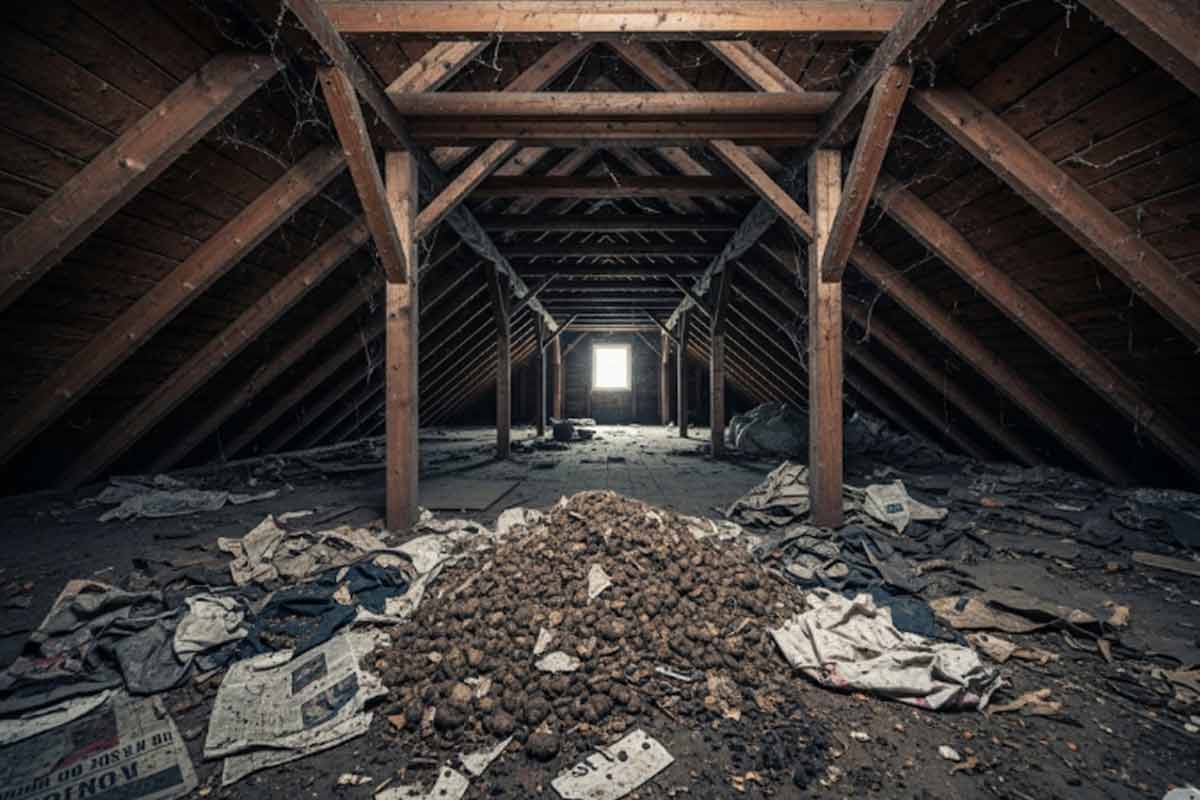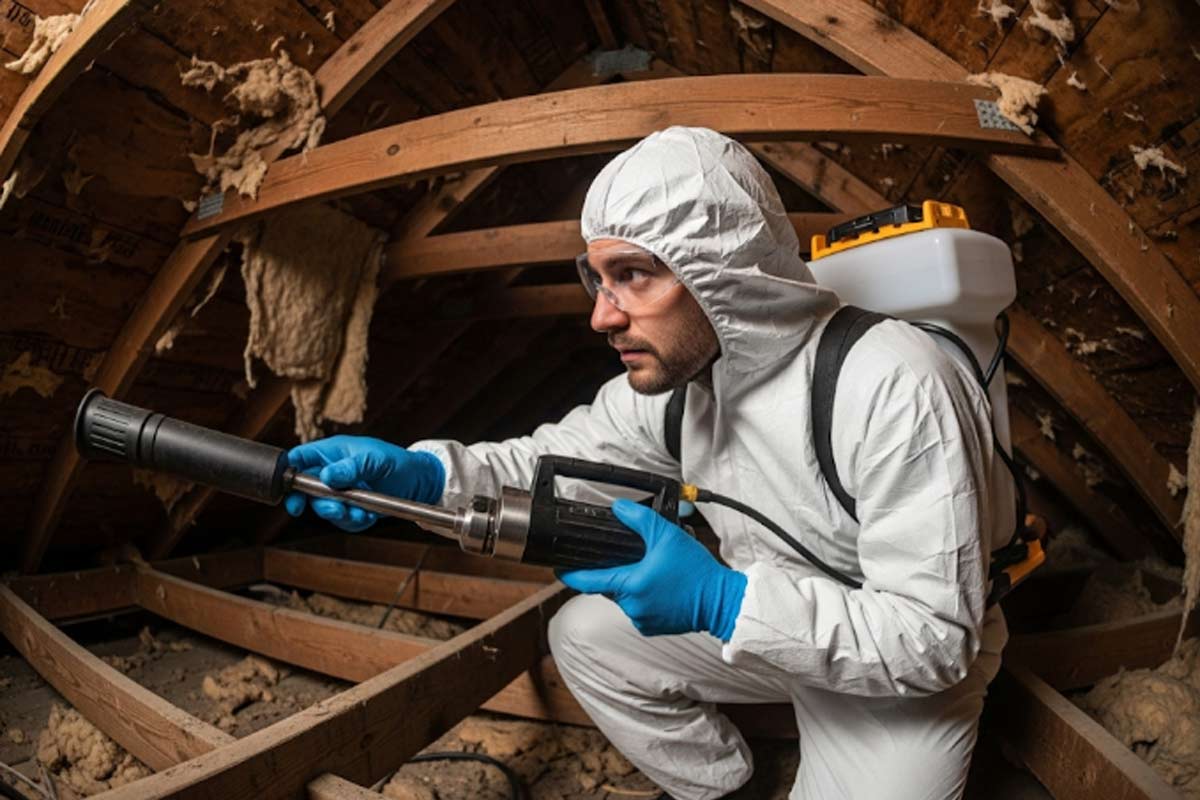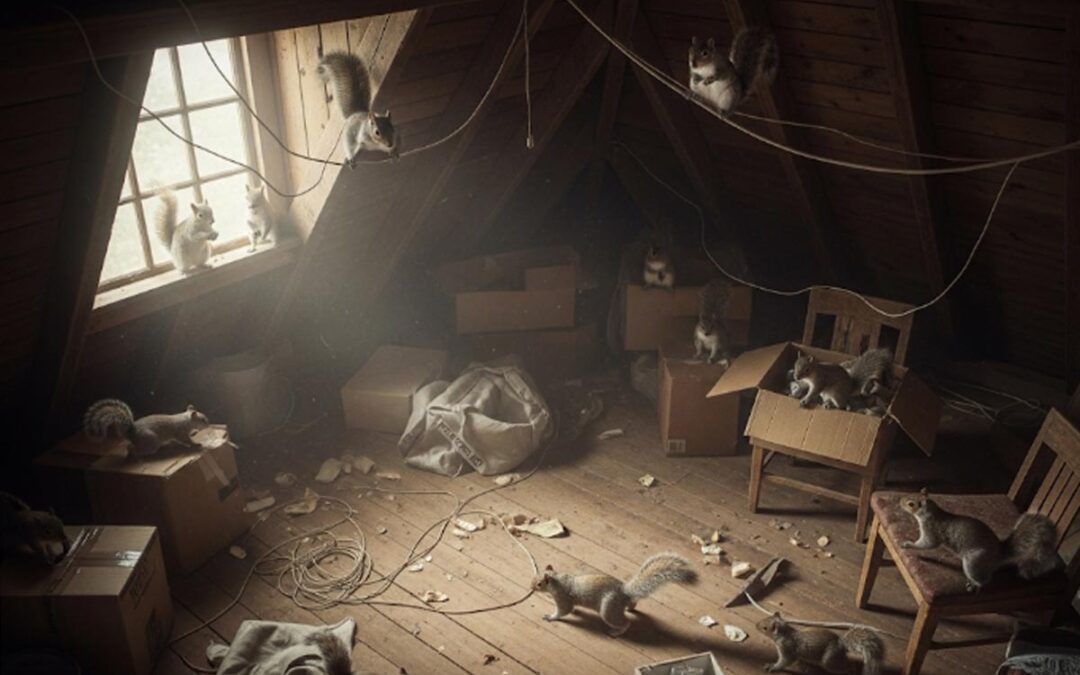Dealing with strange noises or unpleasant smells from your attic can be unsettling. Your attic, often out of sight, becomes a favoured spot for various unwanted guests. This article helps homeowners identify common attic pests and offers advice for managing them. Knowing about typical attic invaders is the first step toward keeping them out and removing them safely.
What Makes Attics Attractive to Pests
Attics offer a prime shelter for many creatures. They provide undisturbed conditions, making them ideal for pests seeking refuge from the elements and predators. This space often holds materials pests can use for nesting and a steady supply of food sources nearby.
- Shelter from Elements
Attics provide a warm, dry refuge from harsh weather, whether it’s the bitter cold of a Canadian winter or the intense heat of summer. This protection is crucial for pests to survive and thrive. Many attic-dwelling creatures seek stable temperatures for their young.
- Seclusion and Safety
An attic is typically quiet and undisturbed, offering pests a safe haven from humans and predators. This isolation allows them to build nests and raise their offspring without frequent interruptions. Pests feel secure in these elevated, hidden spaces.
- Abundant Nesting Materials
Attics often contain insulation, cardboard boxes, old fabrics, and other materials pests can readily use to construct nests. These readily available resources make it easy for them to create comfortable and secure breeding grounds. Attic insulation is particularly appealing.
- Proximity to Food Sources
While attics themselves may not always contain food, they offer easy access to other parts of the house where food is stored. Pests can travel from the attic to kitchens or pantries, making the attic a convenient base for their foraging activities.
- Easy Access Points
Even small gaps or openings in the roof, eaves, or vents provide easy entry for various pests. Deteriorating seals, damaged screens, or unsealed pipe entries offer straightforward access into the attic space. Rodent entry points are often tiny.
- Overlooked by Homeowners
Because attics are not spaces people frequent, pest infestations can go unnoticed for long periods. This lack of human presence allows pest populations to grow unchecked, leading to more significant problems down the road. Hidden pest activity flourishes.
- Stable Temperatures
Compared to outdoor environments, attics often maintain more consistent temperatures, which is beneficial for pests. This thermal stability helps them regulate their body temperatures and ensures the survival of their offspring throughout the year.
Common Attic Pests: Identification and Signs

Identifying the specific pest in your attic is critical for effective removal. Different pests leave distinct clues, from droppings to gnaw marks or unique sounds. Knowing these signs helps determine the type of infestation.
- Rodents (Mice and Rats)
You might hear scurrying noises or gnawing sounds, especially at night. Look for small, dark droppings, often rice-sized for mice and larger for rats. Gnaw marks on wood, wires, or stored items are also common. You may also notice a musky odour. The Canadian Pest Management Association notes that rodents are one of the most common household pests.
- Squirrels
Noises from squirrels are typically louder and heard during the day, including scampering, scratching, or chattering. You may find gnaw marks around entry points or on structural wood. Nests made of leaves, twigs, and insulation might be visible. Squirrels often leave larger droppings than rodents.
- Raccoons
Raccoons produce heavy thumping, growling, or chattering sounds, usually at night. Their droppings are tubular and often contain undigested food. Look for disturbed insulation, torn vents, or widened entry holes, as raccoons can cause significant structural damage. Wildlife experts in Ontario report an increase in raccoon sightings in urban attics.
- Bats
Bats make high-pitched squeaking or scratching noises, particularly at dusk and dawn as they enter and exit. Look for guano, which resembles rodent droppings but crumbles into powder. Staining around entry points from their oils is another key sign. Bats are protected in many parts of Canada, requiring professional removal.
- Birds
Bird activity in the attic usually involves chirping, flapping, and scratching. Nests made of twigs, leaves, and feathers are common, often near vents or eaves. You might find droppings and nesting materials, which can block vents and create fire hazards. Common birds include pigeons and starlings.
- Cluster Flies
These flies appear sluggish and are often found in large groups near windows or light fixtures, especially during colder months. They don’t breed indoors but seek shelter in attics to overwinter. You might see large numbers of dead flies on the attic floor.
- Wasps and Hornets
You’ll likely notice buzzing sounds and may spot nests (papery or mud-like) attached to rafters or walls. Be cautious, as these insects can sting. Activity is most prominent in warmer months. The presence of a nest indicates an active infestation.
- Spiders
While less destructive, a large number of spiders, especially certain species, can indicate other insect activity, their food source. You’ll see webs and possibly egg sacs. Some spiders can be venomous, though most common attic spiders are harmless.
Prevention Strategies
Keeping pests out of your attic is far easier than removing them once they’ve settled in. A proactive approach involves sealing entry points, managing moisture, and regularly inspecting your attic space. These measures reduce its appeal to unwanted visitors.
- Seal Entry Points
Inspect your roof, eaves, vents, and fascia boards for any gaps, cracks, or openings, even small ones. Use wire mesh, caulk, or steel wool to seal these areas. This is crucial for rodent prevention and keeping out insects. A small crack can be a significant entry.
- Repair Damaged Screens and Vents
Ensure all attic vents, soffit vents, and chimney caps are in good repair and properly screened. Torn or missing screens are open invitations for birds, squirrels, and even bats. Regular checks can prevent future infestations by blocking animal entry.
- Maintain a Dry Attic
Moisture attracts many pests, including insects and rodents seeking water sources. Ensure proper ventilation to prevent condensation and address any roof leaks promptly. A dry environment makes your attic less hospitable to a variety of moisture-loving pests.
- Trim Overhanging Branches
Trees or shrubs that touch your roof provide a “bridge” for squirrels, raccoons, and other animals to access your attic. Keep all branches trimmed back several feet from your house. This eliminates easy access for climbing pests.
- Store Items in Sealed Containers
If you use your attic for storage, place items in robust, airtight plastic containers rather than cardboard boxes. Cardboard offers nesting material and is easily chewed through by rodents. This also protects your belongings from droppings and urine.
- Regular Attic Inspections
Periodically inspect your attic for early signs of pest activity, such as droppings, gnaw marks, or nests. Catching an infestation early makes removal simpler and prevents extensive damage. A thorough inspection once or twice a year is recommended for pest detection.
- Remove Food Sources
While attics generally lack food, ensure no food items are stored there. Also, keep rubbish bins sealed and away from the house exterior, as outdoor food sources can draw pests closer to your home and eventually to the attic. Pest control begins outside.
When to Call a Professional

Some attic pest problems are too complex or dangerous for a DIY approach. Knowing when to contact a professional pest control service can save you time, money, and potential injury. Experts possess the tools and knowledge for safe and effective removal.
- Large Infestations
If you notice a significant number of pests, or widespread damage, it’s likely a large infestation that requires professional intervention. DIY methods are often ineffective against established pest colonies. Experts can assess the full scope.
- Dangerous Pests
Pests like raccoons, bats, and certain wasps can be aggressive or carry diseases. Attempting to remove them yourself can lead to bites, stings, or exposure to pathogens. Professionals have the necessary safety equipment and training for wildlife removal.
- Recurring Problems
If you’ve tried DIY methods and pests keep returning, there might be underlying issues, such as unnoticed entry points or a persistent nearby food source. A professional can identify and resolve these root causes for lasting pest solutions.
- Structural Damage
Extensive gnawing from rodents or raccoons can compromise electrical wiring, wooden beams, or insulation. Professionals can assess the extent of the damage and often recommend repairs, preventing further costly issues. Attic damage from pests needs expert review.
- Protected Species
Bats and some bird species are protected under Canadian wildlife laws. Their removal requires specific permits and methods to ensure their safety and legality. Humane wildlife removal is a legal requirement in many cases.
- Time and Resource Constraints
Pest removal can be time-consuming and require specialized equipment. If you lack the time, tools, or confidence to handle the problem effectively, calling a professional is the most practical choice. They have efficient processes for pest elimination.
- Peace of Mind
Dealing with pests can be stressful. Hiring a professional offers peace of mind, knowing that the problem will be handled safely, thoroughly, and effectively, ensuring your home is secure and pest-free. Professional pest management reduces homeowner worry.
Understanding the various attic pests and their habits is crucial for homeowners. From rodents to birds, each creature presents unique challenges and signs of presence. Proactive prevention, including sealing entry points and regular inspections, remains your best defense against these unwanted guests. For persistent or complex infestations, professional help ensures safe and effective removal. Don’t let your attic become a haven for pests.
If you are dealing with a pest problem in Midland or the surrounding areas, professional help is readily available. Contact Mr. Pest Control at our various locations: (705) 739-7378 (Barrie), (705) 326-3377 (Orillia), (705) 739-7378 (Simcoe County), or (705) 739-7378 (Midland & Area).



